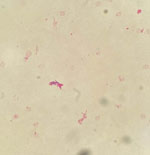Volume 31, Number 3—March 2025
Etymologia
Tsukamurella tyrosinosolvens (tsū-kə-mə-rel′lə tī′-rǝ-sē-nō-sol′vins)
The species name for the bacterium Tsukamurella tyrosinosolvens was accepted in 1997 on the basis of biochemical attributes: tyrosina, from the amino acid tyrosine in cheese (tyros, Greek for cheese), which imparts a crystalline texture (Figure). The hydrolysis, or dissolving of tyrosine—thus, tyrosinosolvens—is a species characteristic.
The genus Tsukamurella consists of commensal bacteria with a propensity to cause opportunistic infections in immunocompromised patients, especially those with chronic lung disease. Tsukamurella bacteria are related to the genera Nocardia, Mycobacterium, Corynebacterium, and Gordonia. Gordonia aurantiaca was initially isolated in 1971 by renowned Japanese physician-microbiologist and Mycobacteria taxonomist Michio Tsukamura at Nagoya University in Nagoya, Japan. In 1988, he was honored with the genus name Tsukamurella.
Tsukamurella, retrospectively isolated by Edward A. Steinhaus in 1941 from the mycetoma and ovaries of the bedbug, was originally misidentified as Corynebacterium paurometabolum. Tsukamurella are weakly acid-fast; therefore, clinical manifestations can be confused with those of tuberculosis and create microbiological misidentification with Mycobacterium and Corynebacterium spp.
Tsukamurella infections are rare and usually associated with immune-suppressed patients, but severe infections have occurred in immunocompetent patients. Currently, of 17 known species, 12 cause human disease. Although Tsukamurella infections have been increasingly reported in Europe, Asia, America, and Africa, T. tyrosinosolvens has been the most common species observed.
References
- Genus Tsukamurella. LPSN—List of Prokaryotic names with Standing in Nomenclature [cited 2024 Dec 27]. https://lpsn.dsmz.de/genus/tsukamurella
- Mizuno S, Tsukamura Y, Nishio S, Ishida T, Hasegawa D, Kosaka Y, et al. Catheter-related bloodstream infection caused by Tsukamurella tyrosinosolvens identified by secA1sequencing in an immunocompromised child: a case report. Ann Clin Microbiol Antimicrob. 2023;22:97. DOIPubMedGoogle Scholar
- Species Tsukamurella tyrosinosolvens. LPSN—List of Prokaryotic names with Standing in Nomenclature [cited 2024 Dec 27]. https://lpsn.dsmz.de/species/tsukamurella-tyrosinosolvens
- Steinhaus EA. A study of the bacteria associated with thirty species of insects. J Bacteriol. 1941;42:757–90. DOIPubMedGoogle Scholar
- Teng JLL, Tang Y, Wong SSY, Fong JYH, Zhao Z, Wong C-P, et al. MALDI-TOF MS for identification of Tsukamurella species: Tsukamurella tyrosinosolvens as the predominant species associated with ocular infections. Emerg Microbes Infect. 2018;7:80. DOIPubMedGoogle Scholar
- Usuda D, Tanaka R, Suzuki M, Shimozawa S, Takano H, Hotchi Y, et al. Obligate aerobic, gram-positive, weak acid-fast, nonmotile bacilli, Tsukamurella tyrosinosolvens: Minireview of a rare opportunistic pathogen. World J Clin Cases. 2022;10:8443–9. DOIPubMedGoogle Scholar
- Yu S, Ding X, Hua K, Zhu H, Zhang Q, Song X, et al. Systematic investigation of the emerging pathogen of Tsukamurella species in a Chinese tertiary teaching hospital. Microbiol Spectr. 2023;11:
e0164423 . DOIPubMedGoogle Scholar
Figure
Cite This ArticleOriginal Publication Date: February 21, 2025
Related Links
Table of Contents – Volume 31, Number 3—March 2025
| EID Search Options |
|---|
|
|
|
|
|
|

Please use the form below to submit correspondence to the authors or contact them at the following address:
Clyde Partin, Emory Clinic, 1365 Clifton Rd NE, Bldg A, 1st Fl, Atlanta, GA 30322, USA
Top